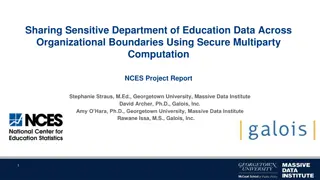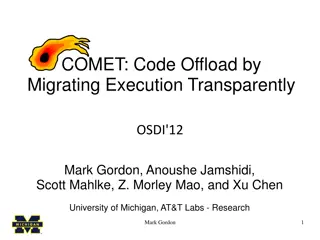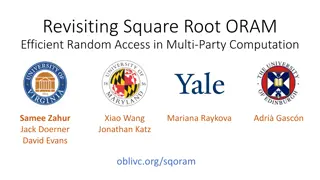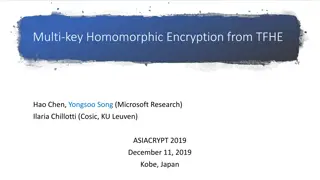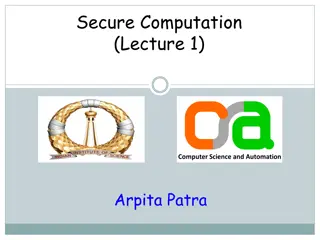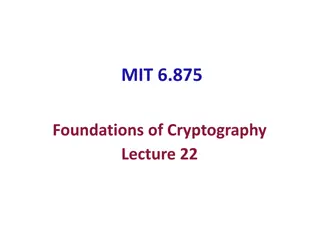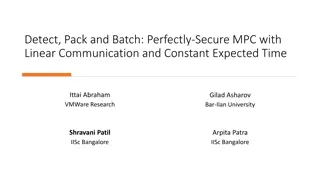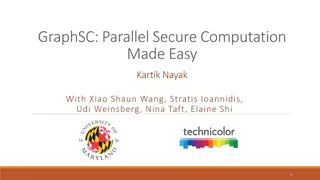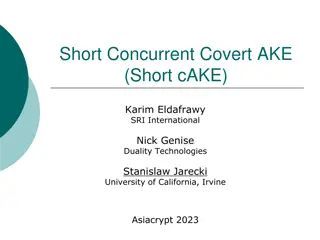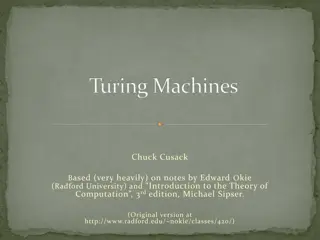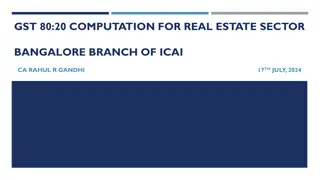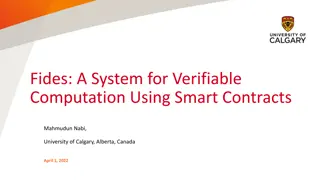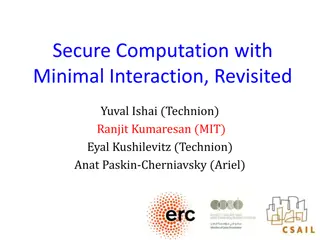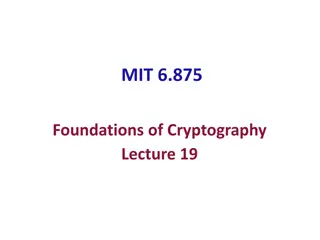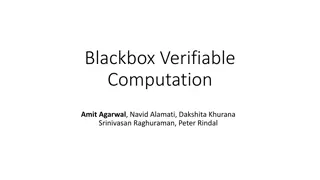Enhanced Security in Multiparty Computation
Explore the improved black-box constructions of composable secure computation, focusing on definitions, objectives, and the formalization basics of multiparty computation (MPC). Learn about the motivating security aspects in MPC and the real/ideal paradigm. Discover how MPC security involves comparing distributions obtained from adversaries and simulators. Dive into the details of computational similarity in secure MPC protocols.
Download Presentation

Please find below an Image/Link to download the presentation.
The content on the website is provided AS IS for your information and personal use only. It may not be sold, licensed, or shared on other websites without obtaining consent from the author. Download presentation by click this link. If you encounter any issues during the download, it is possible that the publisher has removed the file from their server.
E N D
Presentation Transcript
Improved Black-Box Constructions of Composable Secure Computation Speaker: Rohit Chatterjee (Based on work with Xiao Liang and Omkant Pandey)
Part I Definitions and Objectives
(Secure) Multi-Party Computation Interactive protocol! N parties, N inputs. Correctness: At the end of interaction, parties obtain the actual output of the function. Privacy/Security: No party learns any information (apart from that which is given away by function output)
Multiparty computation: Uses Example: Several millionaires come together to find out who is the richest, without revealing their individual net worth [Yao s Millionaire Problem] More current examples: Computing on shared data on the cloud, internet market transactions and auctions, cryptocurrency-related usage. Pretty much any sensitive online multi-user interaction. Auctions Cloud Computing Trading
MPC: Formalization Basics: Can describe the protocol as an interactive protocol among multiple parties [the protocol is a system of randomized algorithms that communicate]. We assume secure, authenticated communication between each pair of parties. Malicious behaviour is captured by (distributed) algorithms called adversaries that can corrupt some subset of parties. Corrupted parties may deviate from normal protocol behaviour.
Motivating security in MPC Want an intuitive `gold standard to judge things against. The best we can hope for is that the function is computed honestly and faithfully. One way to imagine this is to consider an outside authority which we can trust, that computes the function on behalf of the parties. There is really no better we can do! MPC security: Compare things against this gold standard.
MPC: Security Involves the Real/Ideal paradigm IDEAL REAL TTP
More details The outcome can be thought of as a function of the adversary s internal state and what it sees in the protocol. This defines a random variable (remember that the parties all run randomized algorithms). Can now compare distributions obtained from the adversary vs that obtained from the simulator. Similarity can be of three kinds: perfect, statistical or computational. Computational similarity refers to similarity with respect to computationally bounded algorithms (usually, all algorithms running in polynomial time in input size).
MPC: Model What we have defined Common use cases in modern settings are likely to involve several concurrent (and asynchronous) executions of different protocols. Another common situation is when a certain protocol is invoked within another . We want security against multiple concurrent executions of the protocol, and against composition of multiple instances of a protocol. Different functions may be computed in different instances. More relevant/realistic:
MPC: Model (contd.) The properties we want are not available in the plain model (no additional assumptions). Reason: Simulation barriers! Not hard to see why. Need extra/different assumptions. Also need definitions to support what we want, which is: A definition for several MPC executions of a protocol, occurring concurrently. A composition lemma: if two protocols P and Q are secure, then P composed with (or run within) Q is also secure.
Angel-Based Security Angel-based security, or security with superpolynomial helpers, describes a model where the simulator may have access to certain oracles called angels. In fact, the adversary also gets access to the angels. These angels perform some pre-specified superpolynomial time task. This model offers both features we want; i.e.: We can develop protocols in this model that are secure in concurrent settings. There is also a composition theorem.
Round Complexity The total number of rounds (i.e., distinct points where some parties send messages to other parties) in the protocol. Of significant practical interest. Practical runtime of an MPC protocol is tied to round complexity (latency etc). It is also of theoretical interest.
Previously Known Results The Angel-Based security model was introduced by Prabhakaran and Sahai [STOC `04]. Canetti, Lin and Pass [STOC `10] slightly recast the definition to obtain a polynomial-round protocol under standard and polynomial time assumptions. Finally, Goyal et al. [TCC `15] gave a protocol that requires only rounds, under the same assumptions as the previous work. This is the best known protocol in terms of round complexity.
The Black Box issue The notion of `black-box behaviour describes how a program invokes another. This is black-box if the caller program uses only the input- output behaviour of the called program (and nothing besides). Fully black-box algorithms represent a (meaningfully) restricted computational model, hence of theoretical interest. Also much more efficient in practice (avoid Karp reductions of instances, and implementation details of subprotocols). Further, such protocols are not based on specific assumptions.
Previously Know Results [Black-Box] The previously described works are not fully black-box. The first such general MPC protocol in this setting was given by Lin and Pass [CRYPTO `12], with polynomial round complexity. Kiyoshima [CRYPTO `14] gave a construction that brought the round complexity down to . This is the `cheapest protocol known to date.
Our Results Can we get a fully black-box protocol with lower round complexity? In particular, can we eliminate the discrepancy between the round complexities of the best known fully black-box protocol ( ) and the non-fully-black-box one ( )? Our result: yes, and yes! We give a fully-black-box MPC protocol in the Angel-Based security setting that uses only rounds. In doing so, we close the gap between best known black-box and non- black-box MPC constructions for such security.
Part 2 Relevant Notions and Primitives
Commitment schemes We want two properties: Hiding: The commitment reveals nothing about the value committed to the receiver (in the commit phase). Binding: In the reveal phase, the sender cannot decommit to two different values (i.e., to a value other than that it committed).
CCA Security: for Encryption Adversary has access to both encryption and decryption oracles. Very strong definition (e.g.: implies non- malleable encryption) Security definition: adversary cannot guess b with probability much different from half. Motivated by scenarios such as lunchtime attacks
CCA Security: For Commitments Similar principle to CCA-secure encryption. Security: adversary cannot guess with probability much different from half. Also similar to non-malleable commitments (discussed next).
Non-Malleable Commitments Man-in-the-middle adversary . Security condition: `not related to . Not implied by hiding! Adversary can `maul commitments. E.g., consider an adversary that can change Com(x) to Com(x+1). Can cheat in bids. Right session Left session
1-1 CCA Commitments A restriction of CCA commitment scheme where security is only defined for an experiment with exactly 1 left and 1 right session. The security condition is that the adversary cannot distinguish between an experiment where the honest committer commits to vs one where it commits to , with more than negligible probability. Note that the decommitment oracle may possibly be only implementable in superpolynomial time.
Roadmap to Result [CLP`10] proved that an - round black-box MPC protocol can be obtained given a - round protocol for CCA commitments. [Kiyoshima`14] showed a black-box transformation from 1-1 CCA commitments to full-fledged CCA commitments, with a logarithmic overhead in no. of rounds. Consequently, we can achieve an - round black-box MPC protocol given a constant-round black-box protocol for 1-1 CCA commitments (by plugging this in into the existing framework). The latter was an open problem till now.
Part 3 Basic Protocol: Construction and Proof Sketch
Component Primitives Used Want to build a constant-round 1-1 CCA Commitment scheme. We will describe a transformation to make this fully black-box later. We will need the following component schemes. All but the last have known fully black-box constructions. A standard commitment scheme, . An extractable commitment scheme, . An extractable non-malleable commitment scheme, . A witness indistinguishable argument of knowledge, .
Extractable commitments A commitment scheme with the standard hiding and binding properties. Also enjoys extractability: There exists a machine that given black-box access to , can extract the committed value while acting as the honest receiver (usually by rewinding).
Witness Indistinguishable Arguments of Knowledge An IP protocol satisfying the following: Witness indistinguishability: The verifier cannot tell apart which witness was used in the proof. Argument of Knowledge: There exists an algorithm K that can extract a valid witness.
The Protocol Pick uniformly from message space. Set: is referred to as the trapdoor value Prove ( times): (a) is computed correctly OR (b) (trapdoor cond.)
Toy Protocol Trapdoor Phase Proof Phase
Security Condition: Closer Look As described before, consider an adversary interacting with an honest committer and a decommitment oracle in separate sessions. The security condition roughly says that the adversary cannot tell apart the value committed to by the honest committer.
Security Condition (contd.) Formally, the adversary outputs a value at the end of the interaction (can think of this as its guess). This will depend on internal state, protocol messages etc. Security guarantee: the distribution of the adversary s output (as a function of the value committed by the honest committer) is computationally indistinguishable for any two messages in the message space.
Proof of Security We will make a series of changes to move to the desired situation. For each such change, we will show that the adversary s output distribution changing would imply breakage of a cryptographic assumption. This is known as a hybrid argument. We focus on the argument for the synchronous case (keep in mind that adversary controls message schedules!) Notation: Output of a hybrid = Output of adversary in that hybrid.
Proof Sketch: Step 1. Start by extracting and recording this value. Extraction can be thought of as performed separately from original execution Original thread of execution unaffected Adversary cannot detect this change Output is identical! Extract & Store as
Proof Sketch: Step 2. Set . Suppose adversary s output was noticeably different from prev. hybrid. Then this entire experiment serves to tell apart commitments to two different values. Breaks hiding property of ExtCom Get Set
Proof Sketch: Step 3 We switch to proving statement (b) in this hybrid. As before, adversary s output cannot change noticeably. Otherwise, we violate witness indistinguishability of WIAoK. Set Replace witness
A Problem! Remember how the decommitment oracle was supposed to run in superpolynomial time? Note that our component protocols are only secure against polynomial time adversaries. Our described reductions involve the oracle, thus they do not go through.
A `Prequel Hybrid Replace the decommitment oracle. Proof has the committed value! (Hopefully) Use extractor for WIAoK to get decommitment value.
But what if adversary actually proves statement (b) on the right? We show that this happens only with negligible probability in each of our hybrids. Specifically, we show that: We call this the invariant condition.
Invariant Holds Initially Consider the right side execution. If invariant condition does not hold, then we have with non- negligible probability. We can extract with probability close to 1. Contradicts the hiding property of ENMC. Extract
Invariant holds in Hybrids 1 and 3 For hybrid 1, recall that original thread of execution was identical to the initial experiment. Thus, invariant condition has the same probability in this hybrid. Suppose that invariant holds in hybrid 2. Note that invariant is `set by end of trapdoor stage. Now the only change between hybrids 2 and 3 is in the proof stage, so invariant must also hold in hybrid 3.
Invariant in Hybrid 3 Roughly, if invariant is violated, then is `blindly changing 2nd ExtCom on the right in response to change in the left one. But since , this means that must also be changing the left ENMC in response to the right one. Breaks non- malleability of ENMC. Q: Why not use ENMC directly from the committer s side? A: Not compatible with black-box transformation
So far Get Replace witness
Observe that At this point, we note that there is no part of the protocol (apart from the first message) that actually depends on the committer s input. We could have gotten to this last experiment starting from a committer committing to using the same sequence of hybrids.
From the other side Get Replace witness
Finishing the Argument Finally, we can switch the initial commitment to with one to . By the hiding of , this change is undetectable by the adversary. In summation, we conclude that the experiment in which the honest committer uses is computationally indistinguishable from one in which the committer uses (for synchronous adversaries).
Nonsynchronous Case The first half of the argument (up till setting the trapdoor) is actually easier in this setting intuitively, if the messages are not synchronized, there is a `free slot of execution that allows us to extract the trapdoor value on the left. Changing the witnesses becomes a little trickier, but can be done this is why we need multiple WIAoK executions. Instead of switching the witness extraction in the right at the very end, we have to possibly repeat the `detour argument for every change of witness.
Part 4 Black-box Transformation and Conclusions




